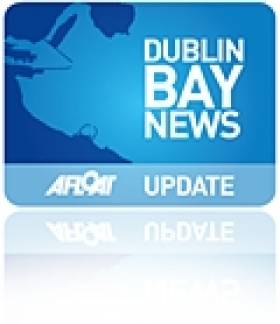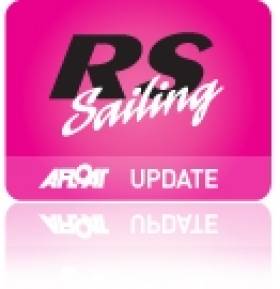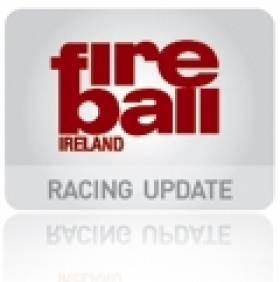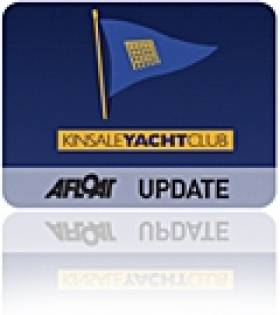Displaying items by tag: Frostbites
Kinsale Yacht Club Frostbites Finally Get Underway
The 2016 Kinsale YC Frostbites finally got going today. Strong winds resulted in the cancellation of the first two weeks so the KYC Sailing Committee, under Race Officer John Stallard, were delighted to have three keenly contested races run today. Conditions were perfect for both the Squib and Laser Fleets, 12 – 14 knots of wind out of the north east and flat seas.
10 Squibs were on the start line. Race 1 saw Cian and Finbarr O’Regan in Fagin take line honours with Jeff Condell and Donal Small in Viking Gold 2nd. Viking Gold took the 2nd Race, in slightly more testing conditions with gusts of 22 knots, with Colm Dunne and Rob Gill in Allegro in 2nd place, while in the final race Fagin again excelled and Allegro came in 2nd. Denis and Brid Cudmore in Sensation put in a very solid performance and came in 3rd in all three races.
5 full rig lasers competed today. Daragh O’Sullivan took the first two races with Siofra Guilfoyle in 2nd and Fergal O’Hanlon in 3rd. However the third race saw Siofra pull ahead and he managed to stay ahead of Daragh to take line honours, Gary Horgan came downwind hot on the heels of Daragh. Daragh held his line and rounded the leeward mark ahead of Gary to come 2nd, Gary came in 3rd.
Dun Laoghaire Motor Yacht Club Frostbites Cancelled
Despite the modest seascape of the above photograph today's Frostbites in Dun Laoghaire have been cancelled writes Cormac Bradley. The weather station adjacent to where this photo was taken was recording 18 knots of wind with a highest gust of 33 knots from the West.
Elsewhere in the harbour, the keelboats moored between Hell's Gates and DMYC were swinging through 90 degrees when they were hit by squalls on the water.
At various intervals, Dublin Bay has disappeared under rain clouds.
Next Saturday night, the Royal St George Yacht Club hosts a celebration of 50 years of Fireballing in Ireland. The great, the good and a big crowd of over 200 are expected.
Window of Opportunity For DMYC Fireball Frostbites
Yet again, the race management team of Dun Laoghaire Motor Yacht Club were able to defy the weather forecast and get a race completed in the Frostbite Series in Dun Laoghaire harbour writes Cormac Bradley. From the middle of last week the forecast for the weekend had been bleak as Abigail worked her way eastwards across the Atlantic. The projected wind strengths on XCWeather were in the mid-twenties with gusts in the range of high thirties to mid-forties. And yet a window opened to allow a solitary race to be completed.
I missed the action on the water – being taxi for members of the family – but caught up with race winners Noel Butler & Stephen Oram derigging in the National Yacht Club afterwards.
Only three Fireballs raced with Conor and James Clancy making their Frostbite debut along with team Keegan. Noel Butler had his regular crew back at the front end but it appears that the Clancys set the pace for the four-lap trapezoid course until Mark 3 on the last lap. It seems that the Clancys chose to gybe at this mark whereas Butler & Oram sailed on and overtook them. The Clancys’ disappointment at losing the race will be offset by the fact that they have secured their Frostbite Mugs early, on the second day of racing!
It was a blustery day on the water with huge wind shifts and an “on-off” supply of wind causing a number of windward rolls – one minute on full trapeze, the next no wind at all. While blustery winds are not unusual for November, the temperature was very unusual. Driving to the harbour my car thermometer was reading 17˚ - very unseasonal.
DMYC Dinghy Frostbites Cancelled Again Due to Strong Winds on Dublin Bay
#dmyc – Due to an adverse forecast and being the Sunday that it is, the last before Christmas, today's DMYC dinghy sailing Frostbite racing was cancelled yesterday evening. It is the third such cancellation in a row for the popular Dun Laoghaire series due to strong wunds
Record 16 RS Dinghies For DMYC Frostbites In Dun Laoghaire Harbour
#dmycfrostbites – Sunday morning dawned bright and sunny, with a gusty 15 knots in Dun Laoghaire harbour writes Marty O'Leary. A record 16 RS dinghies gathered on the startline for the first race of the series of the DMYC frostbites, enjoying exceptionally warm weather for this time of year. Dun Laoghaire welcomed several familiar faces, as well as some visitors from Greystones and further afield.
The race officer set the course at four laps of a trapezoid course based inside the harbour, and racing got off to a clean start, with just one 200 being called back for being a bit too keen.
The early leaders popped out from the left, however no one was safe, with lead changes every leg. First to the windward mark was Sean Clery and new crew Donal Murphy in the 400, followed by Marty O'Leary and Rachel Williamson in the 200. Both boats opted to gybe early at mark two, and were left to watch as the boats that continued on sped by on the right hand side of the run.
It was then the turn of Emmet and James Ryan to take the lead up the second beat, and were looking comfortable as they hoisted the kite - until they managed to get tangled up in a laser, leaving the way clear for George Kingston and Ian McNamee to nip in, and take the lead, chased hard by Andrew and Paul.
The 200s were having their own battles,with O'Leary and Williamson taking an early lead, as class president Frank sailing with Heather Craig, had to turn back and re-cross the line for being OCS. Frank and Heather sailed hard, and chased down the pack and had a great tussle with Conor Totterdell and Myles Kelly. They successfully climbed back to 2nd, but didn't manage to catch O'Leary and Williamson, who collected the weekly mug for the RS's.
Nine Fireballs Initiate 2014/15 DMYC Frostbite Series
#fireballsailing – Despite a Sea Area forecast on Saturday night that suggested sailing would not be an option on Sunday, nine Fireballs took to the start line for the first Frostbite race of the 2014/15 Series. My on the water reporter, Neil Colin (IRL 14775) advises that the combination of the southerly wind direction and a low tide meant that Dun Laoghaire harbour was sheltered from most of the wind, but experienced "mega-shifts".
Earlier in the day the Flying Fifteen experiences and reports from the Turkey Shoot for bigger boats along with the sight of the big red chopper and lifeboat activity suggested there was greater wind offshore.
It seemed like almost all the 75+ entries to date were there to take advantage of the exceptionally mild weather, with boats everywhere!
The standard frostbite square was used, with the committee boat just inside the harbour mouth and the weather mark close to the marina breakwater, to maximise the course size, and maintain some separation between boats close hauled and those downwind. The result was great variances in pressure and direction at the weather mark, tending to support those on the edges of the course, rather than those in the centre.
4 laps were sailed, with great place changing on lap one on every leg, until Kenny Rumball, crewed by Teddy Byrne (IRL 15058) and Noel Butler & Stephen Oram (IRL15061) powered through on lap 2 to make a gap, leaving Neil Colin & Margaret Casey (IRL 14775), Frank Miller & Grattan Donnelly (IRL 14713), Louise McKenna & Hermine O'Keeffe (IRL 14691) and Alistair Court & Gordon Syme (IRL 14706) to tussle for the mid fleet slots.
This group did not see the dice between Kenny & Noel, but expect it was a two way battle, with Kenny & Teddy winning out!
New players Peter Doherty and Ciaran Fitzgerald, sailing IRL 14120, and the re-appearance of IRL 14790 (Shane McCarthy & A.N. Other) made up the fleet.
(Report by Neil Colin, modified words by Cormac Bradley.)
Exhilarating ASM Frostbite Series at Kinsale Yacht Club
#kinsale – After a cancellation last Sunday the ASM Frostbite series came back with a vengeance today. Conditions were described as exhilarating, varying and challenging with race officers reporting winds of between 3 and 25 knots at different stages. The windward mark under Moneypoint proved very problematic with little or no wind to round the mark. The gusts proved too hard for many of the 4.7 and Radial Lasers with numerous retirees and no shows. However the Squib fleet and the Full Laser Fleet embraced the challenging conditions to hotly contest race placings.
At the end of the days racing in the Squib fleet, Allegro (Colm Dunne & Rob Gill ) were placed first on 8 points with Lazurus (Colm Daly & Marcus Hutchinson) following closely with 11 points. KYC Commodore Finbarr O'Regan and his son Colm were lying third in their squib Fagin on 18 points.
In the Full Laser fleet Sean Murphy (KYC) leads on 11 points, James Long ( Inniscarra) lies second on 15 points followed by Ian Travers (KYC) on 19 points. There was only 2 competitors in the 4.7 Laser fleet with Billy Duane (RCYC) claiming all the bullets and Ben Hunt (KYC) taking second place. Racing continues next Sunday 9th.
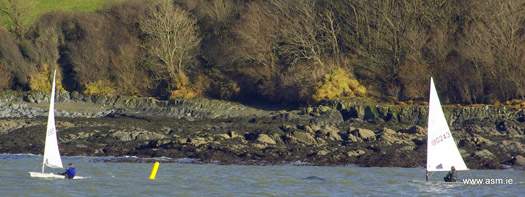
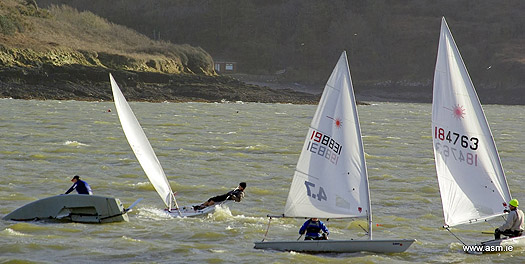
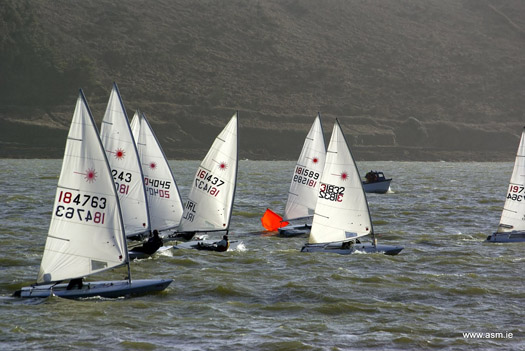


Force 9 Forecast Cancels Fireball Frostbites
#fireball – The last Sunday of Frostbite racing in Dun Laoghaire for 2013 was brought to an early close when the Race Team decided that the combination of the overnight weather forecast (Storm Force 9) and the actual conditions meant that racing should not proceed. There didn't seem to be too much objection to the decision from those who were in the clubhouse of the Dun Laoghaire Motor Yacht Club when the Race Team made their decision public. Some three hours later, when a modest gathering formed at the clubhouse for the series prize-giving, the wisdom of the decision to abandon racing was confirmed when the comment was made "that you wouldn't have wanted to be on the water at 14:45!"
Considering that the entry level for the Frostbites is nearly ninety boats, the turn out for the prize-giving was modest – none of the four classes, PY, Lasers, RS Classes and Fireballs had a full turnout of the 1-2-3 prizewinners. Due thanks were recorded to the Race Team who have provided racing from November 3rd by the principle organizer and MC for the prize-giving at each Sunday and yesterday, Olivier Proveur. He, in turn, was thanked by a member of the Race Team for all his effort.
The Fireball results for Series 1 of the Frostbites have seen an unusual scenario, Messrs Butler and Oram back in third place overall, without a 2013/14 Frostbite Mug in their respective trophy cabinets. However, that observation has to be tempered by the fact that only four points cover the top three boats. The loss of yesterday's race also meant that there is no discard for Series 1 so the results of two weeks ago are now the final results.
|
2013/14 Frostbites: Series 1 Overall (No discard.) |
|||
|
Kenneth Rumball & David Moran |
15058 |
INSC |
12pts |
|
Conor Clancy & Paul Devlin |
14807 |
RStGYC |
15pts |
|
Noel Butler & Stephen Oram |
15061 |
DMYC |
16pts |
|
Mary Chambers & Brenda McGuire |
14865 |
DMYC |
37pts |
|
Neil Colin & Margaret Casey |
14775 |
DMYC |
38pts |
Prizes took the form of "Frostbite calendars" based on the collection of racing photographs taken by Bob Hobby, a key member of the Frostbite Race Team.
For the Irish Fireball fleet, this brings the curtain down on the domestic season for 2013. It saw us lose one regatta during the year when the Open Championships was reduced to a single race in early May in Killaloe. The other stark feature of the season has been the fall-off in numbers, yet those who did turn out for the regattas enjoyed enhanced competition and some memorable racing, particularly at the Nationals in Skerries and the Volvo Dun Laoghaire Regatta where we had wind and glorious sunshine. In what turned out to be a very successful venture we hosted an Open Day in November to try and attract new people into the fleet – we had seventeen "takers".
At international level we had six boats at the Europeans and Worlds in Slovenia and had a top ten finisher in the Europeans with the Rumball brothers, Alexander and Kenneth. At the Worlds, Noel Butler & Stephen Oram together with Kenneth Rumball and David Moran, flew the Irish flag in overall terms and we had one top-ten finish in a race, when Louis Smyth and Cormac Bradley recorded a 9th place. Three Irish boats contested the UK Inland Championships and enjoyed the event so much they are already committed to doing the 2014 event. We should also be taking advantage of the UK Nationals which are scheduled for Wales in August 2014 as a preamble to the Worlds coming to Wales the following year. There is also an expectation that the Irish will be in the Shetlands for the 2014 Europeans.
At a committee meeting before yesterday's abandoned race, the provisional calendar for 2014 was discussed and while there are some key dates (and venues) that need to be confirmed we believe that we have a workable fixture list for 2014, which will be finalized over the next few weeks.
Happy Christmas and a Prosperous New Year to all!
Timing is Everything at DMYC Frostbites
#frostbite – Racing on St. Patrick's Day should have been a sunny green affair. The weather forecast on Saturday was for a nice breeze, moderate temperatures and sunshine. The DMYC committee took the sensible approach of planning to race outside the harbour and to complete two races if at all possible.
Sadly, the morning of St. Patrick's Day in Dublin had snow and sleet and very light winds forecast. Ah well...
The fleets drifted slowly towards the starting boat, which was set in a similar location to March 3rd and which was flying the postponement flag. Many boats set out to find the right tuning for the day, tacking off upwind from the boat and hunting for the right settings while the committee set up a 2-lap course.
The OK Dinghy and GP14 went furthest and were then horrified to hear the horns ending the postponement and beginning the starting sequence. The OK Dinghy was fortunate to make it back and rounded the committee boat at the gun to get a half decent start just behind the Ryan brothers in Richard Tate's RS400. The GP14 was still 30-45 seconds from the line. The IDRA14s and O'Hare's RS400 started closer to the pin end.
Up the first beat it seemed that the start and the course were reasonably fair. The two RS400s lead the way with the 470 next and the OK Dinghy leading the IDRA14s. So far it was pretty standard stuff, but that wasn't going to last.
The angles on the reaches suited the RS400 nicely and the Ryans disappeared into the distance really quickly, with O'Hare next. The 470 led the OK Dinghy which itself was struggling to keep the IDRA14s behind it on the reaches. Rounding the leeward mark ahead of them was vital for a decent result, particularly with the GP14 making a storming charge up the field.
The 2nd beat was where things started to get interesting. The Ryan RS400 easily made it around the windward mark and onto the reaches, but the wind started to ease for the rest of the fleet. The 470 slowed dramatically (pinching?) and the OK Dinghy started to catch up. The GP14 was still charging, overtook the two IDRAs and seemed to be holding or even closing on the OK Dinghy.
Apart from the wind dropping, the tide was now starting to run upwind, adding further complication. The Ryan RS400 was nearing the leeward mark already and had thus missed most of the problem, but for the rest of the fleet the positions were won and lost on the first reach of the 2nd lap. That reach had now become a super light-wind run, into a strengthening tide....one of the hardest of all courses to sail.
O'Hare had gone left looking for breeze and didn't seem to find it, finally reaching back to the gybe mark at a very high angle. The 470 just about kept moving with the spi filling fitfully, but the OK Dinghy was now very definitely catching up and even overtook a competitive Fireball. Sitting STILL on the foredeck of the OK Dinghy does seem to work!
Meantime, with the wind lighter and lighter, the spinnakers on the GP14 and IDRA14s were now essentially useless and the group of three 14-footers got increasingly dropped off the pace.
A handicap race in a dying wind always suits the fast boats, and that's what we saw this week. The Ryans RS400 took the win by 4:48, a huge margin.
The OK Dinghy was 2nd, having somehow kept moving on the light wind reaches. O'Hare was 3rd a further minute down with the 470 four minutes further back in 4th. The 14-footers finished in a tight bunch more than 11 minutes down on the leaders.
Needless to say, there was no 2nd race.
Overall it's still the OK Dinghy in the lead, 6 points clear of the GP14 with Pierre Long's IDRA14 only 2 points further back in 3rd.


























